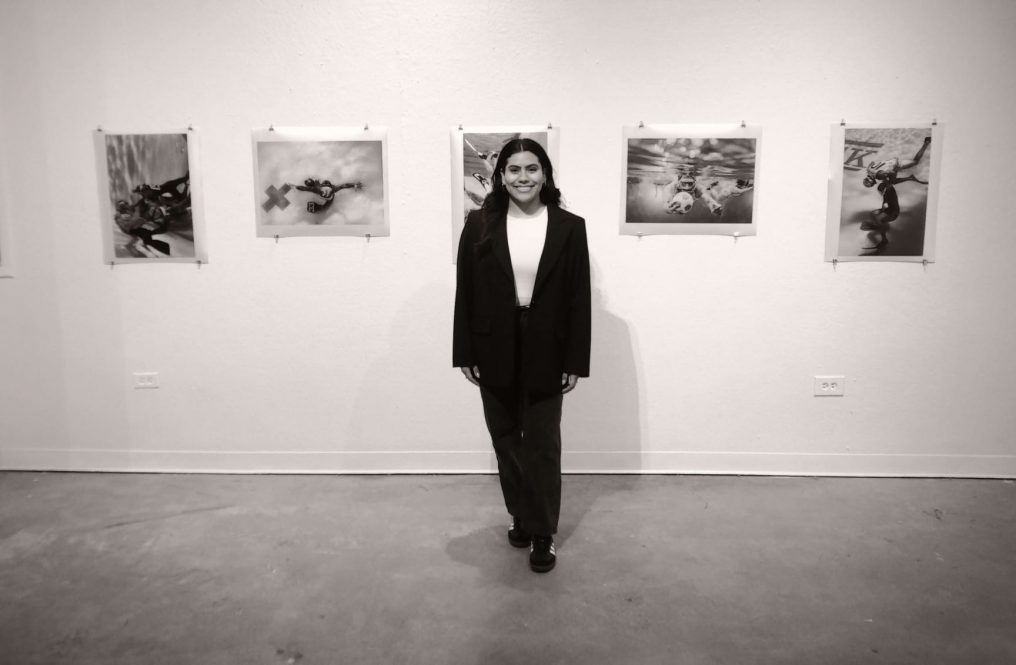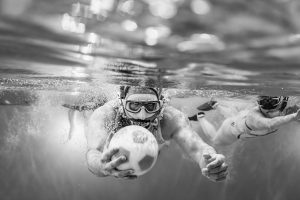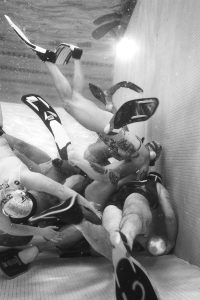Other photographers might find it strange to jump in a pool with a snorkel and a camera: Not Daniela Bedoya

Daniela Bedoya '25 (SFA) spent last summer photographing underwater rugby games and interviewing professional female sports photographers thanks to funding from the BOLD Women's Leadership Network. Her exhibition, "Women in Sports: Behind the Lens," was on display in February. (Photo courtesy of Daniela Bedoya)
Daniela Bedoya doesn't fear the risks of blacking out, going home with a concussion, or any of the other things that could go wrong during a game of underwater rugby.
Sure, the anticipation of World Cup games might threaten to get the best of her, she admits, but there's one thing that's far more nerve-wracking than playing the physical and sometimes blatantly brutal sport - putting her Sony A7 III camera in the water to take pictures of it.
"When I was first training with the underwater case, even though I tested it three times and it didn't leak, I was so nervous to put my camera in and dunk it," Bedoya '25 (SFA) says. "I'm scared even today, and I've spent about a year in the water with it."
Bedoya comes from a family of swimmers. Her father is a swimming coach who played underwater rugby in his home country of Colombia and introduced his daughters to it when they were old enough. Bedoya herself started swimming competitively at 7, always with the 100 and 200 butterfly on her mind, and picked up underwater rugby in high school.
While the family has played part in advancing the popularity of the little-known sport in the United States - there are only a dozen teams in the country, according to the sport's national organization - Bedoya has joined an even more elite group, that of photographers who get in the pool alongside players.

As an art and art history major concentrating in photography and video, she married her two loves into a single project thanks to a scholarship from the BOLD Women's Leadership Network that allowed her to purchase gear, spend last summer in the pool, and interview professional female sports photographers who've jockeyed their way onto the sidelines.
Family friend and Connecticut photographer David Lopez became Bedoya's mentor years ago, as she watched him work with her underwater rugby team, she says.
"He would take videos and pictures and let me see what he was doing and explain why," she explains. "Once I got to UConn, I was fortunate and very blessed to win the BOLD scholarship to merge my two favorite things, but even before then, in all my art projects whether it was ceramics, painting, or drawing, I tried to focus on underwater rugby because I'm so passionate about it."
Underwater rugby is a sport that's played in three dimensions, Bedoya says, because players can move in all directions - above, below, beside, around - other players. A weighted ball is carried between two goals that look like metal trash bins in an attempt to score.
Players wear ear padding for protection, masks over their faces, fins on their feet, and a snorkel. They stay underwater, moving much like minnows in an aquarium, for lengths of time as they move the ball from one end of the pool to the other, coming to the surface long enough to only blow out the water in their snorkel and suck in a deep breath of air.
The sport shares only a name with the game of land rugby, although the two do involve a similar sort of physicality. In underwater rugby, though, spectators watch the game on video monitors because all the action happens beneath the surface.
The Connecticut Makos boasts both men's and women's teams, although neither are currently training, Bedoya says, because finding a suitable pool has proved difficult. In the interim, if she and her teammates want to play, they join the Newark Sea Lions in New Jersey on weekends.
"I've gotten concussions before, and I've blacked out twice because you're holding your breath so long. Now that I say it, it is a pretty dangerous sport. But I've always been in the water, so I do really enjoy it," she says.
Bedoya's BOLD project, "Women in Sports: Behind the Lens," was born from her love for photography and lifetime as an athlete, she says, and started with her interviewing nine female photographers who either serve as team photographers in national leagues or otherwise focus their work in athletics.
That included NHL photographer Sophia Price, Miami Heat team photographer Cristina Sullivan, freelance photographers Laura Wolff and Jody Hou, and NHL photographer China Wong.
"My biggest takeaway from talking to all of them to use one word, I'd say determination," Bedoya says. "You need to be determined in your work, you need to be professional, and you need to make sure those around you know you're in the position you're in for a reason."
She learned from the professionals that female sports photographers sometimes aren't issued accurate credentials to get them into games. Sometimes their work isn't credited. Sometimes they're told to step away from the action, so they don't get hurt.
That's unfair, she says.
With all of that in mind, Bedoya says she looked for a place to practice her sports photography, quickly deciding the sidelines of underwater rugby games was where she wanted to be.
It was a good place to start, she says, because she was familiar with the sport, even as other photographers might find it strange to jump in a pool, snorkel on mask, fins on feet.
Bedoya did not use an oxygen tank because she's not certified for one, so she did what she does during games: She held her breath, and can do so, while moving, for up to 90 seconds, or roughly three laps around the pool.
"I knew the outcome would be great and that I'd bring something to the project that the average photographer wouldn't because they don't know the game," she says.
The hardest part was putting the camera, despite its waterproof case, in the water. The next hardest was keeping it underwater because it kept wanting to float. The third hardest was accounting for the bubbles caused by the players' movements that dotted almost to obscurity the final images.
"Sometimes I'd see a player with a ball and their teammate was on the other side of the pool, and think to myself, 'I could just put my camera down and help,'" she says. "I needed to manage my headspace. I was there to shoot, not as a player, and needed to get into my zone and start photographing."

That resulted in a series of photographs depicting images of determined individuals, powerful in their stance, fierce in their eyes, yet oftentimes graceful in their underwater rhythms. The exhibition was on display in the Art Building in early February.
Those who didn't see the show will be able to catch the next, on display in April during the art and art history department's annual spring BFA art show. As a senior, who will finish classes in December, Bedoya will be one of dozens showing off their work in the Art Building.
"It was hard for me to say I'm done with this project let me move onto another one my senior year," she says. "My advisor told me to do what makes me happy and excited, because no one wants to work on something they're not inspired by. I've learned a lot since last summer and have put those new techniques to work."
Even as recently as early this month, she traveled to New Jersey for a game.
She also notched another new experience in her hoped-for profession when she was asked recently to photograph a UConn men's hockey game.
"I was like, 'Of course!' Do I know a lot about hockey? Absolutely not. Have I ever shot a game? No. Would it be a great experience? For sure. I think that was something I got out of my interviews last summer," she says. "Even if you don't feel 100% prepared, don't limit yourself. Just push through and remember that you were asked for a reason. Maybe someone sees something in me that I don't see. Just have that confidence to say, 'Yes, I can do that,' and then show up with confidence and show you can do it."






